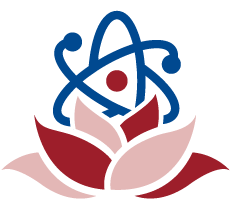| avoidance གཟུར་བ། | neurosci. | |
| Avogadro’s principle ཨ་ཝོ་གྷ་ཌོའི་རྩ་འཛིན། | phys. Equal volumes of all gases at the same temperature and pressure contain the same number of molecules, 6.02 X 1023 in 1 mole (a mass in grams equal to the molecular mass of the substance in atomic mass units). | དྲོད་ཚད་དང་གནོན་ཤུགས་གཅིག་མཚུངས་ཡིན་པའི་སྐབས་སུ་བོངས་ཚད་གཅིག་མཚུངས་ཡིན་པའི་རླངས་གཟུགས་ཚང་མའི་ནང་དུ་འདུས་རྡུལ་གྱི་ཁ་གྲངས་གཅིག་མཚུངས་ཡོད་པ་སྟེ་མཱོལ་ (གྷ་རམ་དུ་ཚད་འཇལ་བའི་གདོས་ཚད་ཅིག་ནི་འདུས་རྡུལ་དེའི་གདོས་ཚད་ཨེ་མུ་རུ་ཚད་འཇལ་བ་དང་མཚུངས་) གཅིག་གི་ནང་དུ་འདུས་རྡུལ་ 6.02 X 1023 ཡོད་དོ། |
| Avogadro’s number ཨ་ཝོ་གྷ་ཌོའི་གྲངས། | phys. The number of atoms or molecules in one mole of a substance, equal to 6.023 × 10²³. | དངོས་རྫས་མཱོལ་གཅིག་གི་ནང་དུ་ཡོད་པའི་རྡུལ་ཕྲན་ནམ་འདུས་རྡུལ་གྱི་ཁ་གྲངས་ཏེ་ 6.0221367 x 1023 དང་མཚུངས། |
| avian dinosaurs གཤོག་ལྡན་གཏུམ་འབྲུག | biol. | |
| average speed ཆ་སྙོམས་མགྱོགས་ཚད། | phys. Path distance divided by time interval. Average speed=total distance covered/time interval | ལམ་ཐག་དེ་དུས་ཡུན་གྱིས་བགོས་པའི་བགོས་ཐོབ། ཆ་སྙོམས་མགྱོགས་ཚད། = བགྲོད་པའི་ལམ་ཐག་ཆ་ཚང་།/དུས་ཡུན། |
| Availability Bias དྲན་སླའི་ཕྱོགས་རིས། | neurosci. | |
| AV node (atrioventricular node) སྦུབས་མདུད། | biol. A small mass of tissue in the right atrioventricular region of higher vertebrates through which impulses from the sinoatrial node are passed to the ventricles. | མཐོ་རིམ་སྒལ་རུས་ཅན་གྱི་སྲོག་ཆགས་ཀྱི་སྙིང་སྦུབས་ཀྱི་གཡས་ཕྱོགས་ཁུལ་དུ་ཡོད་པའི་ཕུང་གྲུབ་ཀྱི་གོང་བུ་ཆུང་ཆུང་ཞིག་ལ་ཟེར་ཞིང་། འདི་བརྒྱུད་དེ་འགྲོས་མདུད་ནས་སྙིང་སྦུབས་སྨད་ལ་འཁྱུག་བརྡ་བརྒྱུད་གཏོང་བྱེད། (སྦུབས་སྟོད་སྨད་བར་གྱི་མདུད་པ་ཡིན་པས་ན།) |
| autumn equinox སྟོན་མཉམ། | phys. | |
| autotroph རང་གསོ། | biol. Literally ‘self-feeder’. An autotrophic organism is one that can obtain energy directly from sources other than ingested or absorbed food. Autotrophic processes include photosynthesis and chemosynthesis. | སྒྲ་བཤད་དུ་ “རང་གསོ་བ་” ཞེས་བརྗོད། འཚོ་ནུས་རང་རྟེན་གྱི་སྐྱེ་དངོས་ནི་མིད་ཚར་བའམ་འཇིབ་རྔུབ་བྱས་པའི་ཁ་ཟས་ལས་གཞན་པའི་ནུས་པའི་འབྱུང་ཁུངས་ནས་ནུས་པ་ཐད་ཀར་ལེན་ཐུབ་མཁན་ཞིག་རེད། འཚོ་ནུས་རང་བརྟེན་གྱི་བརྒྱུད་རིམ་དུ་འོད་ཀྱི་སྦྱོར་སྡེབ་དང་རྫས་རྡུལ་སྦྱོར་སྡེབ་གཉིས་ཚུད་ཡོད། |
| autosome དཀྱུས་ཕུང་། | biol. Any chromosome that is not a sex chromosome. | མཚན་མའི་ཚོས་ཕུང་མིན་པའི་ཚོས་ཕུང་གང་རུང་རུང་ཞིག་ལ་གོ |
| autoradiogram འགྱེད་རྡུལ་རང་པར། | phys. A photograph of an object produced by radiation from radioactive material in the object. | དངོས་པོ་ཞིག་གི་ནང་དུ་ཡོད་པའི་འགྱེད་འཕྲོ་རང་བཞིན་ཅན་གྱི་དངོས་རྫས་ཤིག་གི་འགྱེད་འཕྲོ་ལ་བརྟེན་ནས་བསྐྲུན་པའི་དངོས་པོ་དེའི་པར་ཞིག |
| autopsy བེམ་བཤེར། རོ་དཔྱད། | biol. Examination of a cadaver to determine or confirm the cause of death. | ཤི་རྐྱེན་ངོས་འཛིན་ནམ་ཐག་གཅོད་བྱེད་པའི་ཆེད་དུ་མིའི་རོའི་སྟེང་དུ་སྒྲུབ་པའི་བརྟག་དཔྱད། |
| Autopolyploid རིགས་གཅིག་མང་རྐང་། | biol. | [རིགས་གཅིག་ནས་བྱུང་བའི་ཚོས་གཟུགས་མང་རྐང་།] |
| autonomous clock རང་འགུལ་དུས་འཛིན་འཁོར་ལོ། | neurosci. | |
| autonomic nervous system རང་འགུལ་དབང་རྩ་མ་ལག | neurosci. The part of the nervous system that regulates involuntary action, as of the intestines, smooth muscle, heart, and glands, and that is divided into two physiologically and anatomically distinct, mutually antagonistic systems, the sympathetic nervous system and the parasympathetic nervous system. | རྒྱུ་མ་དང་། འཇམ་ཤ སྙིང་། རྨེན་བུ་བཅས་ཀྱི་རང་འགུལ་གྱི་བྱ་བ་སྟངས་འཛིན་བྱེད་མཁན་གྱི་དབང་རྩ་མ་ལག་གི་ཆ་ཤས་ཤིག འདི་ནི་ཕུང་གནས་རིག་པ་དང་རོ་བཀྲའི་རིག་པ་གཉིས་ཀྱི་སྒོ་ནས་ཕན་ཚུན་ཐ་དད་ཅིང་འགལ་ཟླ་ཡིན་པའི་མ་ལག་གཉིས་ཏེ་གཅེས་ཚོར་དབང་རྩ་མ་ལག་དང་ཉེ་བའི་གཅེས་ཚོར་དབང་རྩ་མ་ལག་གཉིས་སུ་དབྱེ་ཡོད། |
